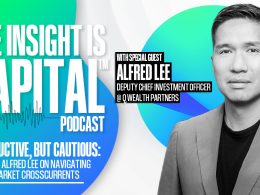by Liz Ann Sonders, Jeffey Kleintop, Kathy Jones, and Kevin Gordon, Charles Schwab & Company Ltd.
Inflation trends are moving in a favorable direction, but the change is likely too slow for the Fed to take its foot off the brake anytime soon.
For their part, central banks abroad are slowing their rate hikes and international stock markets have responded positively. The MSCI Euro Index, which tracks the stock market performance of companies based in the eurozone, has delivered its best performance since the late 1990s so far this quarter.
U.S. stocks and economy: Fed in the middle
To be sure, inflation is still high in relative historical terms, even if rates are slowing. And wage growth is proving too stubborn for a Fed keen on holding down inflation expectations. Average hourly earnings grew 5.1% from a year earlier in November, according to the most recent jobs report, and the annualized gain over the prior three months (which is a better gauge of the near-term trend) was the fastest since January.
The Atlanta Federal Reserve bank's wage growth tracker corroborated the trend, showing headline growth of 6.4% in November, with both job switchers and job stayers seeing gains, as shown in the chart below.
Get paid to stay or go
Source: Charles Schwab, Bloomberg, as of 11/30/2022.
The Atlanta Fed Bank defines a "job stayer" as someone in the same occupation and industry as a year earlier, and with the same employer in each of the last three months. A "job switcher" includes everyone else (i.e., people in a different occupation or industry or employer).
Then again, the Fed is likely still far from declaring victory on the inflation front. Stronger wage growth goes hand-in-hand with higher unit labor costs, which are in turn highly correlated with inflation. As you can see in the chart below, the two-year percentage change in unit labor costs rose to 11.2% in the third quarter, the fastest since the early 1980s. Such gains don't mean workers are getting more productive, either: Productivity's 1.4% drop was the worst since 1975.
Productivity sags as labor costs spike

Source: Charles Schwab, Bloomberg, as of 11/30/2022.
With a hawkish Fed intending to keep rates higher for longer, the return of a higher risk-free rate has important implications for stock investors. Not only are stock fundamentals coming back into play courtesy of higher rates and economic weakness, but the market's leadership profile is decisively shifting. Gone are the days when the market's gains depended on the performance of just a handful of stocks (i.e., the "big five" or the "super seven"). As shown in the chart below, the equal-weighted S&P 500 Index has outperformed its market capitalization-weighted peer by its largest margin since 2010.
Getting equal

Source: Charles Schwab, Bloomberg, as of 12/9/2022.
The S&P 500® Equal Weight Index (EWI) is the equal-weight version of the widely used S&P 500. The index includes the same constituents as the capitalization-weighted S&P 500, but each company in the S&P 500 EWI is allocated a fixed weight—or 0.2% of the index total at each quarterly rebalance. Indexes are unmanaged, do not incur management fees, costs and expenses and cannot be invested in directly. Past performance is no guarantee of future results.
Fixed income: A widening gap
The market is pricing in a steep rise in the federal funds rate

Source: Bloomberg.
Market estimate of the federal funds rate using Fed Funds Futures Implied Rate (FFM2 COMB Comdty). As of 12/12/2022. For illustrative purposes only. Please read the Risk Disclosure for Futures and Options prior to trading futures products. Futures accounts are not protected by SIPC.
Falling commodity prices, a weakening housing market, and a slowdown in manufacturing point to disinflationary forces already at work. But the prospects for future foreign demand are also weak, given how both developed and emerging-market countries have struggled with this year's spike in energy costs.
Global PMI tends to move in tandem with 10-year Treasury yields

Source: Bloomberg, S&P Global. JP Morgan Global Manufacturing PMI, Diffusion Index SA (MPMIGLMA Index), US Generic Govt 10 Year Yield (USGG10YR Index). Monthly data as of 11/30/2022.
Past performance is no guarantee of future results.
Average hourly earnings

Note: Pre-pandemic average 2.7% date range 10/31/2015-12/31/2019.
Source: Bloomberg, using monthly data as of 8/31/2022. US Average Hourly Earnings All Employees Total Private Yearly Percent Change SA (AHE YOY% Index).
Atlanta Fed Sticky Price Index

Source: Federal Reserve Bank of Atlanta. Atlanta Fed Core Sticky 12 CPI Month (SCPICS12 Index), Not Seasonally Adjustable (NSA), percent change YoY. Monthly data as of 10/31/2022.
Note: The sticky price index sorts the components of the consumer price index (CPI) into either flexible or sticky (slow to change) categories based on the frequency of their price adjustment.
In past cycles, the Fed has lowered rates soon after hitting the peak

Source: Bloomberg. Federal Funds Target Rate - Upper Bound (FDTR Index). Daily data as of 12/12/2022.
Note: Data is the short-term interest rate targeted by the Federal Reserve's Federal Open Market Committee (FOMC) as part of its monetary policy. Past performance is no guarantee of future results.
We suggest fixed income investors focus on the long-term outlook rather than trying to second-guess near-term Fed policy decisions. Current yields for high-quality bonds such as Treasuries and other government-backed bonds, investment grade corporate bonds and municipal bonds are the highest in several years. A laddered approach to investing in bonds can offer a way to invest for income without trying to time the market.
Global stocks and economy: Best quarter ever
Best quarter ever for eurozone stocks

Source: Charles Schwab, Bloomberg data as of 12/8/2022.
Performance for Q4 2022 covers 10/1/2022 through 12/8/2022. Indexes are unmanaged, do not incur management fees, costs and expenses and cannot be invested in directly. Past performance is no guarantee of future results.
- The U.S. Federal Reserve has slowed the pace of rate hikes from 75 basis points (bps) in November to 50 bps in December.
- That follows the Bank of Canada stepping down from 75 bps in late October to 50 bps in December and saying it would consider "whether the policy interest rate needs to rise further."
- The central banks of Australia and Norway stepped down from 50 bps to 25 bps at their meetings back in October/November and repeating 25 bp hikes in December.
- The central bank of one of the largest emerging-market economies, Brazil, along with the central bank for the largest emerging-market economy in Europe, Poland, both paused a few months ago, leaving rates unchanged at recent meetings.
As a possible counterweight to this trend of slowing hikes, China's reopening as it winds down zero-COVID protocols could increase inflation and lead to central bank rate hikes in 2023.
The shift from the aggressive pace of hikes that took place for much of 2022 took place at the start of the fourth quarter and aligned with the shift in market performance from the bear market that unfolded in the first three quarters of the year, giving us a fourth-quarter rally. Leading that rally has been international stocks. Since the start of the fourth quarter, the MSCI EAFE Index of international stocks climbed 20% by the start of December and is outperforming the S&P 500 on a year-to-date basis, despite this year's big gain in the U.S. dollar.
The outperformance by international stocks may continue in 2023. International stocks tend to possess more of the characteristics, like high dividend yields and lower price-to-cash-flow ratios, that have contributed to outperformance within and across sectors and countries this year. Earnings growth is also stronger outside the United States, and analysts expect it to remain so in 2023. The year-over-year growth earnings growth for S&P 500 companies in the recently reported third quarter was 4.1%, compared to 30.5% for companies in Europe's STOXX 600 Index. Combined with lower valuations, this has supported international stock outperformance, which may become more pronounced with a pause or reversal in the sharp rise of the dollar that characterized much of 2022.















